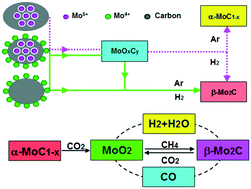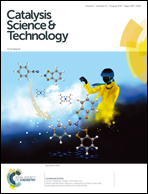Simple synthesis of ultrasmall β-Mo2C and α-MoC1−x nanoparticles and new insights into their catalytic mechanisms for dry reforming of methane†
Abstract
Highly dispersed β-Mo2C and α-MoC1−x nanoparticles with average diameters of 3.88 ± 1.21 and 1.79 ± 0.72 nm, respectively, were synthesized by a simple resin-based carbothermal reduction route. It was interesting to note that the nature of the Mo carbide phases obtained considerably depended on the precursor preparation method and flowing gas composition. Under flowing Ar gas, the precursors prepared by ion-exchange, impregnation and mechanical mixture methods were transformed into α-MoC1−x, a α-MoC1−x/β-Mo2C mixture and β-Mo2C, respectively. However, under flowing H2 gas, all the precursors were converted to β-Mo2C, regardless of the precursor preparation method. The complete synthesis processes involved reduction–carburization of Mo oxide precursors via the pathways of nontopotactic MoO2 → β-Mo2C or MoOx (Mo4+ or/and Mo5+) → MoOxCy → β-Mo2C, and topotactic MoOx (Mo5+) → MoOxCy → α-MoC1−x. It was generally accepted that there were two possible mechanisms of dry reforming of methane (DRM) on β-Mo2C, the redox mechanism (involving β-Mo2C ⇆ MoO2) and the noble metal type mechanism, with the former much more dominant than the latter. In this work, we addressed for the first time the differences in the two mechanisms between β-Mo2C and α-MoC1−x. Over the α-phase, the redox mechanism involved the transformation of α-MoC1−x → MoO2 ⇆ β-Mo2C and this pathway was minor in comparison to the noble metal type mechanism. Clearly, the contribution of the noble metal type mechanism to the DRM activity on the α-phase was more than that on the β-phase, which was proposed to account for the better stability of the former than the latter. It was therefore suggested that the noble metal type mechanism should be preferable for DRM over carbide catalysts.

- This article is part of the themed collection: 2017 Catalysis Science & Technology HOT Articles


 Please wait while we load your content...
Please wait while we load your content...